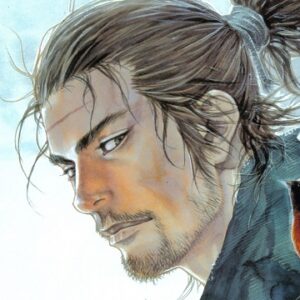Miyomoto Musashi, a samurai born during Japan’s Edo era, went on to become the finest swordsman of the time. He was a gifted boy who learned the art of swordfighting at a young age and won his first duel at the age of thirteen. Musashi spent the majority of his life travelling around the countryside, pushing people to prove his toughness and capability. In his lifetime, he won sixty duels, some of them were against several opponents. He was the creator of the Hyh Niten Ichi-ry or Niten-ry swordsmanship style, as well as the author of ‘The Book of Five Rings,’ a book on strategy, tactics, and philosophy that is still extensively read and referred to today.
Childhood and Adolescence
Miyamoto Musashi’s exact year of birth is unknown, although he is claimed to have been born in 1584 in the Miyamoto hamlet in Harima Province to Shinmen Munisai, a martial artist and master of the sword and jutte.
Musashi is said to have been raised in Shoreian temple by his uncle Dorinbo when he was seven years old. Dorindo, a Buddhist disciple, educated the little lad in Buddhism. He was even taught the fundamentals of reading and writing.
His father taught him swordsmanship and the family skill of jutte. The training, however, was short-lived, as his father was sent to the village of Kawakami. Yoshioka-ryu dojo school was where he acquired his formal schooling.
Career of Miyamoto
At the age of thirteen, he fought his first battle against the samurai Arima Kihei, who fought in the Kashima Shinto-ryu style, which was founded by Tsukahara Bokuden. With his swordsmanship prowess, he successfully challenged the latter. He left his hometown in 1599, leaving his family’s belongings with his sister and brother-in-law. He spent a lot of his time in duels with other people. A conflict sprang out between the Toyotomi and the Tokugawa the following year, in 1600, during which he supported and fought on the Toyotomi side against the Tokugawa. Little is known about what happened when he vanished from the side.
Following that, he is said to have challenged Yoshioka Seijuro, the Yoshioka School’s master, to a duel. The latter agreed to the combat, which would take place outside Rendaiji in Rakuhoku, Kyoto’s northern district. He was crowned ‘Unrivaled Under Heaven’ after winning the duel. He traveled widely around Japan in Musho Shugyo, a warrior pilgrimage place, from 1605 until 1612. During this time, he developed his talents in preparation for the duels. Meanwhile, he began zazen practice at the Myoshinji Temple in 1611. He met Nagaoka Sado, a vassal of Lord Hosokawa Tadaoki, there. Takodi, on the other hand, was a powerful lord who had been granted the fief of northern Kyushu following the Battle of Sekigahara.
He had a duel with Saski Moire, also known as ‘The Demon of the Western Provinces,’ the next year (1612). He did, however, outpace the latter with a bokkeh he constructed from an oar. He preserved his usual sign of arriving late in this bout as well. In 1614, he took part in another battle between the Toyotomi and the Tokugawa, but it is unclear which side he supported. In 1615, he worked for Lord Ogasawara Tadanao of Harima Province as a foreman or construction supervisor. To get the job, he had to first earn the necessary qualifications.
During his time as a foreman, he assisted in the construction of Akashi Castle. He went on to teach martial arts to students, specializing them in the skill of shuriken throwing. He also adopted a son, Miyamoto Mikinosuke, about the same period. In front of the lord of Himeji, he overcame Miyake Gunbei and three other Togun ryu adepts in 1621. He began building the town of Hemji after his combat with Miyake Gunbei ended in a spectacular victory. He then created ‘Writings on the Sword Technique of the Enmei-ryu,’ a scroll of Enmei-ryu teachings for his newly established school. The school’s major goal was to teach samurai how to use two swords as effectively as a pair of swords and jutte.
After his adoptive son was made a vassal in 1622, he embarked on a second journey, eventually arriving in Edo in 1623, where he met Confucian scholar Hayashi Razan. He applied for a swordsmaster post with Shotgun at Edo but was turned down. Following his refusal, he moved to Oshu, where he adopted a second son, Miyamoto Lori, and moved to Osaka with him. In 1633, he began training and painting with Hosokawa Tadatoshi daimyo of Kumamoto Castle, who had relocated to the Kumamoto fief and Kokura. The following year, he married Lori and moved to Kokura, where he later served the daimyo Ogasawara Tadazane.
He was a key figure in the Shimabara Rebellion, which began in 1637 on the western island of Kyushu and was led by Christian peasants. This was his sixth and final fight in which he acted as a strategist, commanding troops.
He became the retainer of the Kumamoto Hosokowa lords around 1640. He wrote the ‘Hyoho Sanju Go’ or ‘Thirty-five Instructions on Strategy’ for Hosokawa Tadatoshi the next year. This piece later served as the inspiration for ‘Go Rin No Sho.’
Personal History and Legacy
In 1642, he began to experience attacks of neuralgia, which caused his health to deteriorate. He retired to the cave of Reigando the next year, where he wrote ‘The Book of Five Rings.’ He completed the project in 1645. He died of thoracic cancer on June 13, 1645. His body was entombed in armor in the town of Yuge, near the main route near Mount Iwato, facing the Hosokawas’ journey to Edo.
Estimated Net Worth
Musashi is one of the wealthiest kickboxers and one of the most popular. Musashi’s net worth is estimated to be $1.5 million, according to Wikipedia, Forbes, and Business Insider.
Trivia
He is the author of ‘The Book of Five Rings,’ a well-known classic on Japanese samurai strategy.


